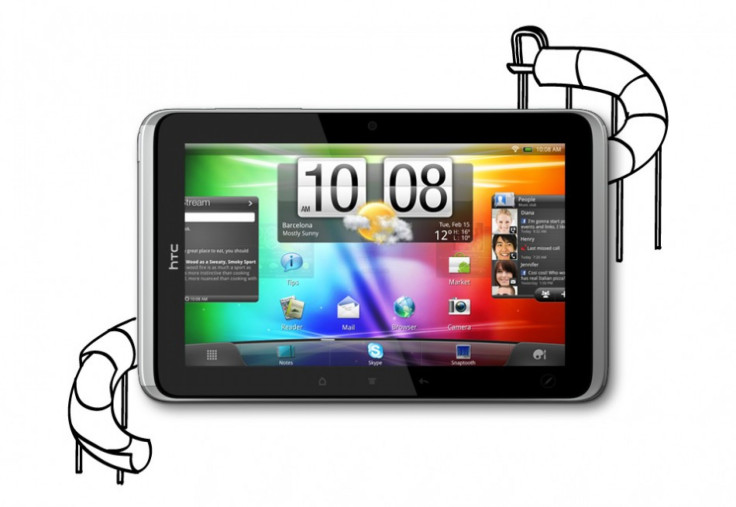HTC's tablet Flyer vs RIM's PlayBook: Who's the winner?

HTC released its 7-inch Android tablet Flyer at the Mobile World Congress (MWC) in Barcelona while BlackBerry maker RIM announced that it will offer its tablet PlayBook in HSPA+ and LTE versions.
Both HTC Flyer and RIM PlayBook come in 7-inch form factor but have a different OS that brings these tablets to life. While HTC Flyer has been chided for using an older version of Android, when a tablet-specific Android, the Honeycomb is present, the PlayBook has a different flavor in its QNX OS which has been built ground-up for tablets.
Operating System:
HTC Flyer runs on Android 2.4 or Gingerbread and uses a modified version of HTC Sense UI which brings 3D experience to its users. HTC's focus has been to customize its HTC Sense UI for its Flyer rather than laying excessive weight on the underlying platform. On the other hand, RIM's PlayBook uses its new QNX OS which is a departure from its BlackBerry OS used in its phones.
RIM bought QNX Software Systems, a maker of real-time operating system, in April 2010. QNX created the Neutrino real-time operating system, software well adopted by the automobile industry to power Bluetooth integration, device connectivity and similar systems.
Thus, PlayBook has an edge as it offers a new OS with novelty on its side. Also the fact that users are aware that Gingerbread was crafted primarily for smartphones and Flyer uses the same underlying OS will go against the HTC tablet. InformationWeek had reported that PlayBook also offers a different multi-tasking experience as it keeps apps running simultaneously rather than suspending them.
Processor:
HTC Flyer is powered by a Snapdragon 1.5 GHz processor which fades in the light of PlayBook's dual core 1 GHz TI OMAP processor. Engadget reported that TI OMAP 4430 - the processor that PlayBook uses NVIDIA Tegra 2 and Samsung Exynos were benchmarked on browser and graphical points by AnandTech for smartphones and LG Optimus 3D's OMAP 4 came out trumps with significant improvements beating the likes of iPhone 4 and Motorola Atrix. The Flyer seems rather challenged taking on the dual-core processor and it will also affect its future adaptability of Android 3.0, as the OS is best optimized with a dual-core chip.
Resolution and Battery:
Both Flyer and PlayBook sport 1024x600 in screen resolution and both have the resolution to do justice to 1080p video playback. However, the screen resolution for HTC Flyer comes at the price of lesser battery life compared to PlayBook. PlayBook offers 6 hours in battery life while Flyer returns a paltry 4 hours. HTC's fallout on the battery life could also be due to the use of Gingerbread, as earlier versions of Android on tablets are known for weaker battery life. In its Android 3.0 avatar, Motorola Xoom offers 10 hours in battery life.
Memory:
In the memory segment, both Flyer and PlayBook are comparable though PlayBook comes in variants of 8, 16, 32 and 64GB internal memory while HTC comes in only 32GB configuration. Both offer 1GB in RAM but coupled with a dual core processor, PlayBook can have more speed compared to Flyer's 1.5 GHz chip.
Camera:
HTC Flyer offers camera configuration of 5 MP rear-facing and 1.3 MP front-facing cameras while PlayBook offers 5 MP rear and 3 MP front-facing camera. InformationWeek reported that PlayBook offers 1080p video capture ability while Flyer's video capture support is currently not known but Flyer has specs to support this configuration which would make it a level-playing field, as for video chats the camera configuration does not affect the quality much.
Sensors:
HTC Flyer offers developers the works with G-sensor, compass and ambient light. The only sighting of a sensor on PlayBook has been of an accelerometer while it hasn't been revealed if there exist other sensors.
HTC Flyer offers a strong differentiator as it offers a stylus which helps with note-taking. The technology is called HTC Scribe Technology which also uses a feature called Timemark which enables a user to capture the audio of a meeting in line with the written notes. Thus tapping on a word in the notes instantly takes a user to that exact place in time in the audio recording of the meeting.
The challenge for RIM is that it does not offer too many apps for its PlayBook and since its OS is at a nascent stage, developers are still getting accustomed to the new OS. However, InformationWeek had earlier reported that in one of the company videos, RIM had shown how existing Adobe AIR and Flash applications can be converted into PlayBook apps. Also recently Bloomberg reported that RIM is working on software which will allow the device to run Android applications, in order to give its users more access to applications in the Android Market.
Thus, the battle is between a new OS and an old OS on a 7-inch ring. Here is a comparison between HTC's Android-based Flyer and RIM's PlayBook:
HTC Flyer | RIM PlayBook | |
OS | Android 2.4 | QNX |
Processor | Snapdragon 1.5 GHz | TI OMAP dual core 1 GHz |
Display | 7-inch | 7-inch |
Resolution | 1024x600 | 1024x600 |
Memory | 32 GB | 8,16,32,64 GB |
RAM | 1GB | 1GB |
Video Playback | N.A | 1080p |
Camera | 5 MP rear, 1.3 front | 5 MP rear, 3 MP front |
Wi-Fi | 802.11b/g/n | 802.11a/b/g/n |
Sensors | Ambient light, G-Sensor, Digital compass | Accelerometer |
Battery | 4 hrs | 6 hrs |
Weight | .9 lbs | 0.9 lbs |
© Copyright IBTimes 2025. All rights reserved.





















